12 instructor-led training activities for before, during, after training

Despite all the hype around new ways to deliver training , over half of all employee training hours are still spent in instructor-led classrooms, according to ATD’s 2018 State of the Industry report. This is slightly up from previous years, showing that face-to-face interactions remain core to the learning experience.
All that time and expense makes it imperative that organizations maximum the value generated by these in-person training sessions. It’s within that context that Sam Cauthen presented one of our most popular webinars to date, “Get more out of ILT.”
Cauthen is the COO and Head of People Operations at Poll Everywhere, with a background in consulting, organizational design, and marketing. Her webinar makes a simple case: effective instruction-led training primes attendees before class, engages them during class, and reinforces teaching after class.
54% of the learning hours are spent in traditional, instructor-led face-to-face classrooms according to the ATD State of the Industry 2018.
“All of this matters because of the important role growth and mastery have in employee life cycles,” said Cauthen, citing Gallup and Steven Schmidt. “The perception of growth and mastery has been shown to be correlated – in fact, key – to metrics businesses care about: employee engagement, retention, and ultimately company value.”
I have summarized the key takeaways from Cauthen’s “Get more out of ILT” webinar, as well as the follow-up “Using Poll Everywhere to maximize impact before, during, and after your ILT” webinar, which is embedded below. Included are several examples of ways you can use Poll Everywhere to gamify corporate training or any other ILT you’re planning.
Instructor-led training activities before your class
Find out what attendees expect from the training
Reach out to attendees with a short survey as soon as they sign up for your training. This survey will help you assess expectations and familiarity with the material. Present the results at the beginning of training to further clarify what will (and will not) be covered.
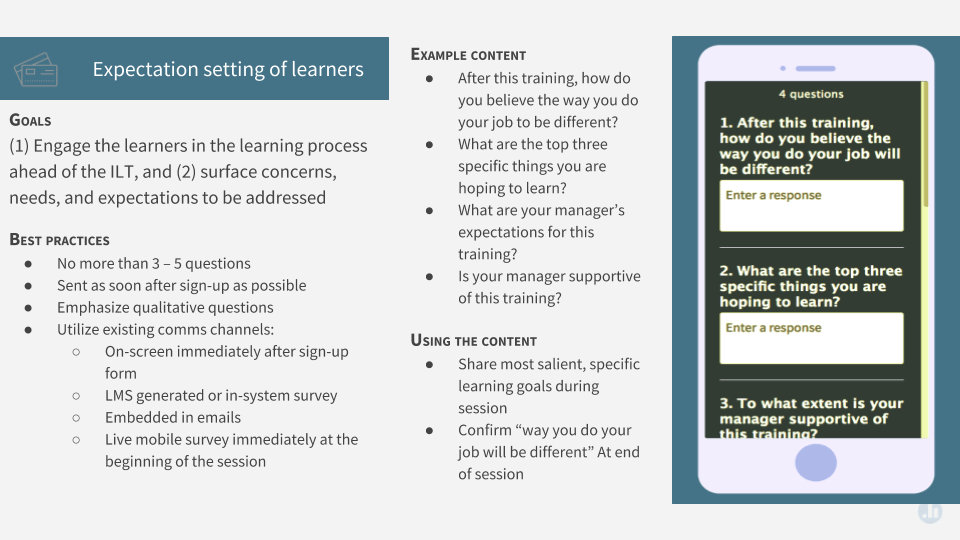
This survey is different from a needs-assessment survey (discussed below), and more closely resembles an opinion poll. A few example questions are in the slide above. Asking these questions before your training shows that you’re interested in the attendee’s success, and signals that this will be an active learning experience. This creates a conducive learning environment for everyone.
Here is a basic pre-training survey you can replicate in Poll Everywhere. Copy these questions to a survey activity. Each question includes a note suggesting which activity type to use for that question. When you’re finished, share the survey with your attendees using the sharable response link. Results appear automatically in your account as they are received.
- How do you think the way you work will be different after this training? (open-ended)
- What are the top three specific things you are hoping to learn? (open-ended)
- What are you manager’s expectations for this training? (open-ended)
- From 1 to 5, how supportive is your manager of this training? (multiple choice)
Find out what managers expect attendees to learn during the training
Attendees will tell you what they want to learn, but managers will tell you what they need to learn. Engaging direct managers, either with another survey or a 15-minute interview, is vital to defining the goals of your instructor-led training. Managers can also help reinforce what you taught if they know, and support, the training’s goals.
Here is a modified version of the pre-training survey for managers:
- How do you think employees will work differently after this training? (open-ended)
- What are the top three specific things you hope employees will learn? (open-ended)
- What are you expectations for this training? (open-ended)
- From 1 to 5, how supportive are you of this training? (multiple choice)
Build curiosity and anticipation with simple activities
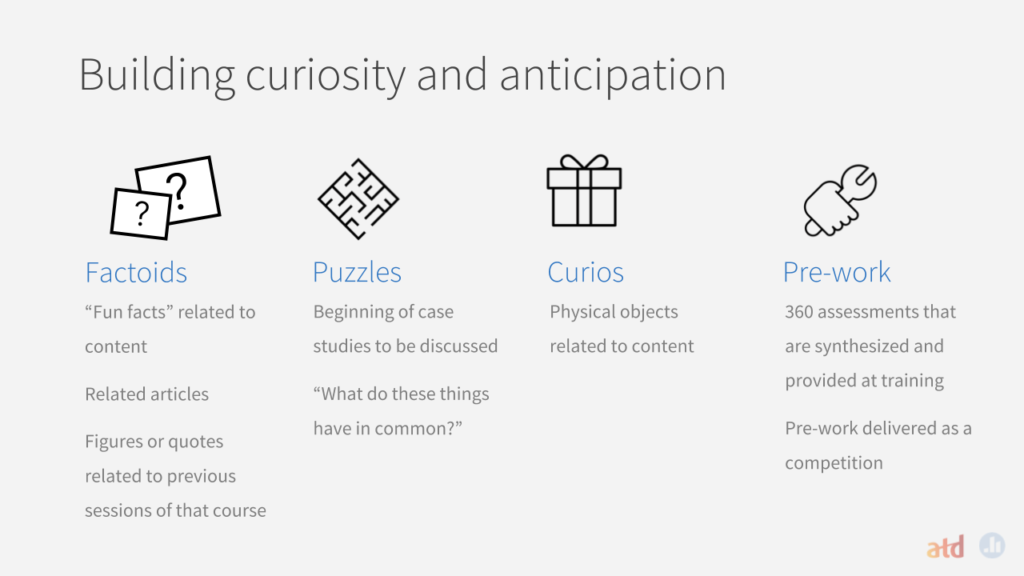
“When attendees are curious,” Cauthen said, citing this article, “they work harder to find answers, remember those answers, and feel like they’ve been rewarded.” The slide above contains some ideas to gamify the start of your corporate training. Think of them as homework assignments before the class begins.
You won’t use all of these ideas for every class. Instead, Cauthen recommends you pick and choose based on the subject matter and preferences of your attendees. She called out the pre-work activities in particular as being well-suited for managerial or coaching training sessions. You could frame those activities as a daily trivia context leading up to the training itself. The results would then be shown at the start of the training; a great way to tease out what will be discussed.
Instructor-led training activities during your class
Anonymous discussion
Yale professors Gabriel Grant and Jason Jay use open-ended polling with Poll Everywhere in their workshops on facilitating difficult conversations. Grant and Jay ask attendees to think of specific conversations that ended in “gridlock” and then reply to an open-ended poll, “What are you thinking and feeling about the other person but not saying?”
The group then discusses the responses, and workshops more productive ways to handle these conversations. Poll Everywhere anonymity settings ensure these discussions are focused on what is being said, and not who said it.
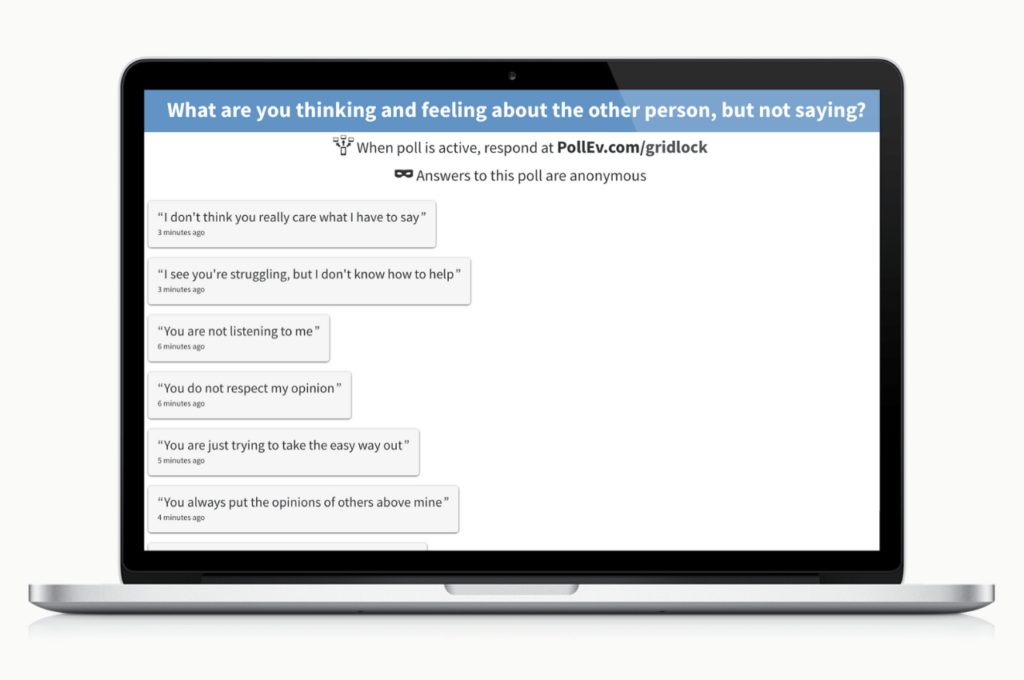
Mind mapping
Mind mapping or bullet journaling helps attendees break down complex concepts into digestible nuggets of information. Mind maps are then displayed during breaks – roadshow style – and discussed with other attendees.
Choose-your-own-adventure
Choose-your-own-adventure (COYA) is a classic technique for gamifying your corporate training. Here’s the idea: Give the audience a what-would-you-do-in-this-situation scenario, and ask them to decide as a group on the next steps. Use a Poll Everywhere Q&A to manage their responses at scale. After each attendee responds, they see a list of everyone else’s responses and can upvote their favorites. The response with the most votes is the official answer to your CYOA scenario.
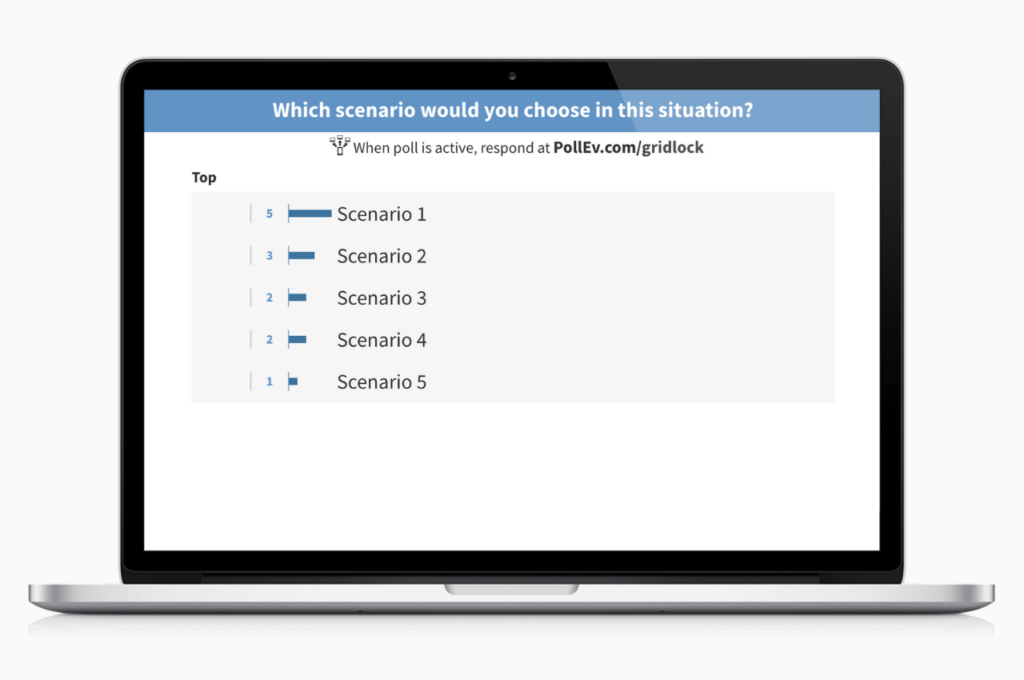
Commitment letters
Commitment letters are a way of helping attendees translate the concepts they just learned into actions. Have each person pen a letter to themselves outlining how they are going to act on the information presented during the training. You then wait 4 – 6 weeks before sending those letters back to their authors. Later on, attendees should receive a brief survey asking how they delivered against the commitments they made to themselves.
Advise wall
Relationship-building activities have been growing in popularity. Find them all in the slide below:
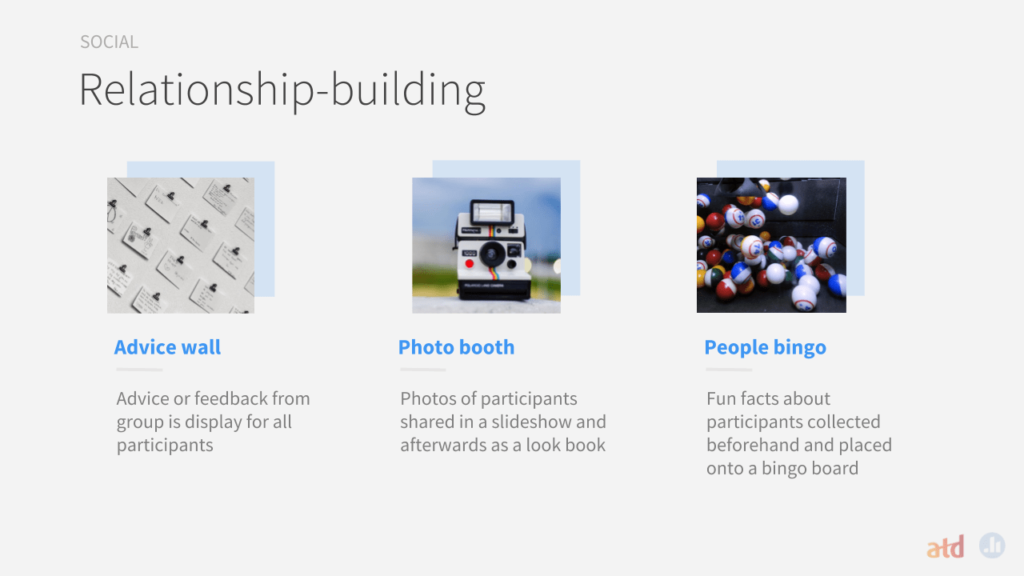
An advice wall is easy to create and share using Poll Everywhere. You can click to copy an advice wall activity straight to your account with the link below. The activity is an open-ended one using the Spotlight visualization. Spotlight gives each response from the audience its 15-seconds of fame. Responses scroll from top to bottom, pausing briefly on each so the audience can read what it says. Share the live results link with your attendees so they can refer back to the advise wall after training ends.
Copy: What’s one piece of advice you learned from today’s training?
Instructor-led training techniques after your class
This stage of the process is too often neglected. Citing Knowles’ Theory of Andragogy, Cauthen said, “Adults need to be involved in the planning and evaluation of their instruction.” That evaluation starts with the pre-class survey mentioned earlier, and ends with post-class activities such as a “Lookbook” of attendees and targeted follow-up questions. Cauthen’s preferred post-class activities are ones that summarize and synthesize what attendees learned.
Custom infographic
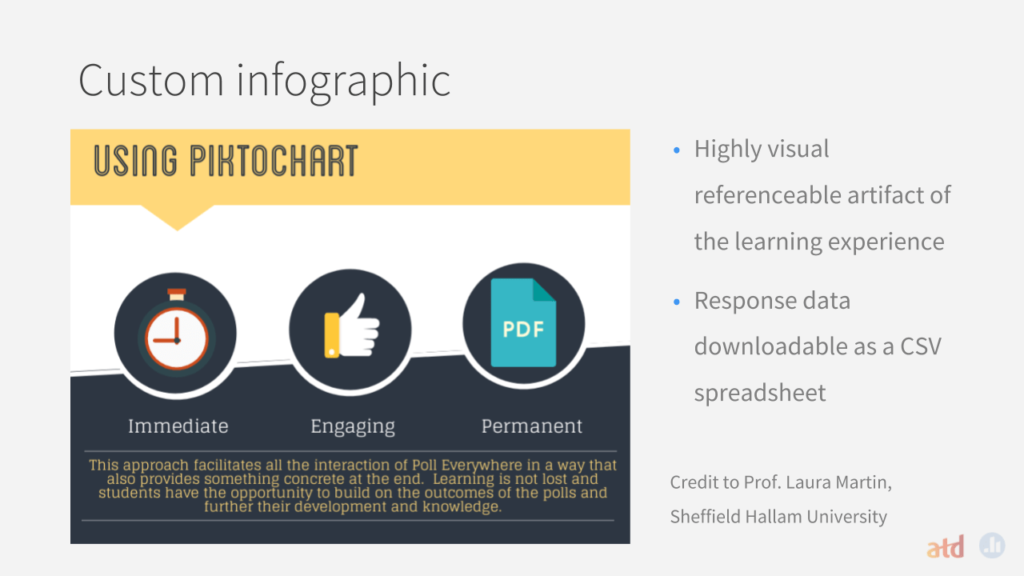
Instructors who use a lot of attendee participation and interaction in their training will sometimes prepare an infographic template to be completed and distributed after class. The template is filled in with individual responses from the attendee who is receiving it, or is an aggregate of all responses from the class. Either way, this infographic acts as a visual reminder of the training.
Job aids co-developed during training
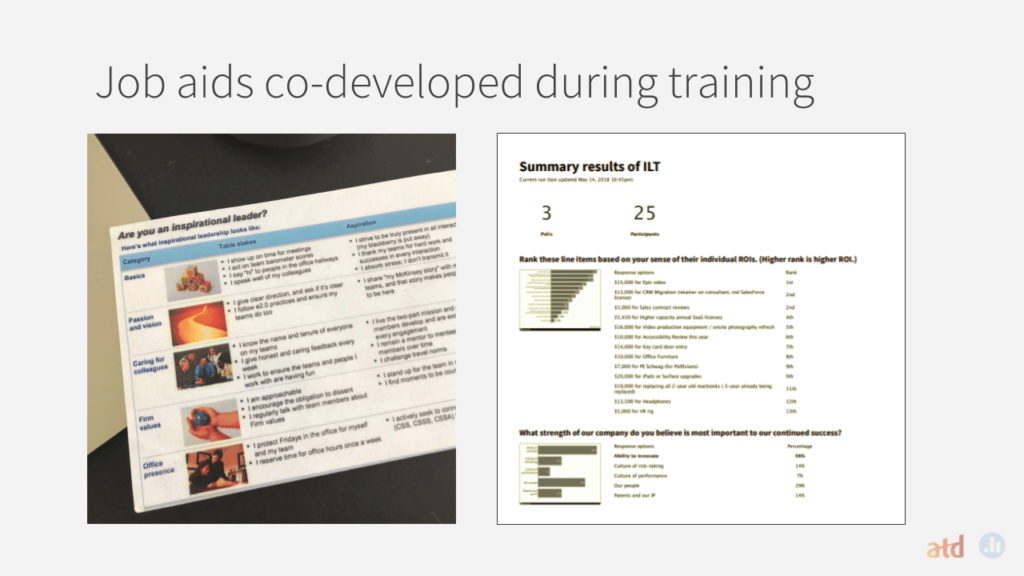
The image on the left in the slide above is a job aid Cauthen has kept on her desk for the past 14 years. As she explained, this aid is powerful because it is germane to the experience itself and recalls activities that went into creating it. The image on the right is a facsimile of this aid created using a Poll Everywhere report.
Reports in Poll Everywhere give you a summary of how everyone responded to your activities, and come in different styles depending on the type of information you need.
Finish your feedback survey before attendees leave
Cauthen cautioned against waiting to send out any sort of feedback survey about the training. The longer you wait, she argued, the more likely it is that attendees will get distracted, forget, and not complete the survey. If you’re going to collect audience feedback on your training, make it the very last thing you do during your training. Have it be the last thing people do before they leave.
Review with friendly competition
Another way to cap off your corporate training is with a fun trivia game using Poll Everywhere Competitions. This activity is a customizable quiz game, and you’re the host. Attendees earn points for speed and correctness, and a leaderboard appears between questions to show everyone who is in the lead. A burst of confetti accompanies the final leaderboard to celebrate the winner.